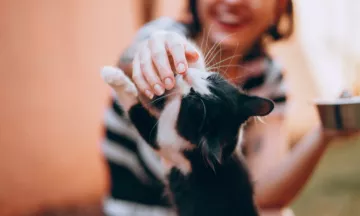Should my dog be more independent?
It’s essential for your dog’s emotional well-being to have some healthy independence. A happy, independent dog can be calm in its own company and less likely to fret when left alone for short periods of time.
Teaching your dog independence is especially crucial during the pandemic if you live in a state that has been locked down. Returning to work or school can be a big change for a dog, who may be used to having you home all day. Furthermore, if you adopted a dog during the pandemic, they may not know a life outside of you working from home.

What can happen if my dog is too dependent?
A needy and dependent dog is at risk of developing separation anxiety. Although it can be nice to feel needed by your furry friend, this level of anxiety is really stressful for both the dog and owner. A dog with separation anxiety simply cannot feel safe and secure when faced with a change in routine. Most importantly, they have trouble coping with being away from their favourite humans, making a return to work or school really difficult.
Separation anxiety can manifest in many ways. For example, your dog might bark, chew and scratch, go to the toilet in odd places, become aggressive, depressed or even get into harmful situations while trying to escape.
It’s important to note that your dog might normally seem fine, but that any dog can feel some level of anxiety in an unfamiliar situation. This is especially important if you’re preparing for your dog to stay with a pet sitter. Be sure to discuss these things with the pet sitter during your meet and greet, and make a plan with them about what to do if your dog gets stressed.

How do I teach my dog independence?
It’s really crucial to set your dog up to be independent as early as possible. Prepare for changes that might trigger anxiety by looking at what is coming up in the near future. For example, you might know that the school holidays are ending or you are returning to work. Don’t wait until the day before: the more time you spend preparing your dog, the better for your dog.
Make sure your dog has a safe, cosy spot to curl up in and a safe environment in the home. They might have a crate, a cosy basket or a kennel with warm blankets. In addition to this, take time to puppy-proof your home if your dog could get hurt or escape while you are out.

Take your dog for a walk or training session before you leave the house, as this will help burn some anxious energy. Dogs need both physical and mental stimulation every day in order to be calm and happy. And of course, a chew toy or Kong can be a nice treat for your dog while you are out. Gnawing and chewing can be a very soothing activity for a jumpy dog.
And lastly, give your dog plenty of opportunities to practice being home alone. Go through the whole process of getting ready and leaving the house without a fussy goodbye. Doing this a few times a day will help your dog to feel secure in knowing you will soon return.
For dogs that have serious separation anxiety, it may be necessary to seek professional help from a dog trainer. Furthermore, a pet sitter can walk or play with your dog during the day. This can really help ease your dog into post-pandemic life by helping to maintain a routine.
Need a pet sitter to take the edge off when you go back to work? Click below to start searching!





